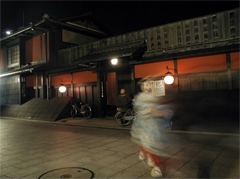
[Editor's note: Wanderlust has again gripped Steve Burgess right in the...Well, suffice it to say he's on the road in Asia and writing home to The Tyee once a week. Here's the second dispatch.]
By the time I saw the building I had stopped looking for it. Afraid to find it, perhaps. Wandering around Kyoto's Gion district, the fabled home of the ancient geisha tradition, I had been keeping an eye out for the Ichiriki, the big, red, wooden pavilion that is the improbable home of Japan's premier geisha establishment. Six years ago I had the rare privilege of being entertained inside its walls. Now here I was back in Kyoto, and suddenly here it was in front of me -- an implacable fortress of solitude, disguised as a Japanese barn. I steeled myself for an assault.
Travel books can't map out the private journeys we take. My trips to Japan -- this is my third -- have been in some part a retracing of my first overseas trip in the spring of 2001. It was a strange and powerful experience, one in which fascination and intense discomfort ran parallel like crowded Tokyo trains.
I travelled then with a Japanese television reporter named Kaori. We met in Vancouver, had a memorable date, then corresponded by e-mail after she returned home. My pre-existing plan to visit Japan in spring was gradually adapted to become a month-long tour for two that would make use of Kaori's extensive contacts to open up the country for a first-time visitor. A grand plan. That it also amounted to a continuous 26-day second date was a fact that was gnawing at my gut as I boarded the flight at YVR.
Warp-speed curiosity
A little commitment-phobic, Steve? Point taken. But Japan would make for a mind-blowing overseas debut at the best of times. Fold that blast of confusion together with a warp-speed romance conducted with all the preamble of an arranged marriage -- a cross-cultural, cross-linguistic one at that -- and you may understand why, before the trip was done, I had developed a rather nasty stress rash.
It went both ways, of course. Once we were on a Tokyo subway car and I was emitting my usual flood of questions -- "What's that ad say? What's that sign mean? Why does that funny-looking thing do?" -- when I turned to see Kaori softly weeping, finally overwhelmed by the strain of my constant curiosity and the responsibility of being a worthy host and guide.
But while we struggled on, Kaori was systematically opening to me the wonders of Japan. Her greatest coup came in Kyoto. Kaori was a student of Go, the complex board game that, like chess, is truly mastered only by a few. Her mentor and teacher was an older man who was president of a successful construction company. For decades that company had been patrons of the Ichiriki Ochaya, Japan's most celebrated geisha establishment. Long-term relationships like these are essential in the "floating world" that is geisha culture. No amount of money can gain entry to the Ichiriki, or any top geisha establishment, if no prior relationship exists. Witness Memoirs of a Geisha author Arthur Golden, who set much of his novel's action at the Ichiriki. The author never got inside the place himself. Didn't know the right people.
Sentinels at the gate
Kaori knew the right person. One night we took a taxi to the Gion district and disembarked at the courtyard of the Ichiriki, where we would be guests of her friend and mentor. Although he would never divulge the figure, it was entirely possible that our evening's entertainment would cost him and his company as much as $5,000 US.
I have written of that evening before, and space does not permit a full recap here. Suffice to say it was memorable -- at times magical, at times almost banal. The mistress of the Ichiriki herself, a woman whose family had run the establishment for generations, joined us to sip sake. We were also joined by two geiko (as geisha are commonly called in Kyoto) named Yuiko and Komomo, and by one apprentice geiko, known as a maiko. Her name was Teruhina, and she was just 18 years old at the time. Her kimono was a shimmering green and silver with a collar that cost $5,000 alone, and adorned with a $50,000 belt. She also had a Hello Kitty watch, which she proudly showed me. I countered with a 3-D Astro Boy wallet. We looked out at the full moon and sang, "Who's Afraid of the Big, Bad Wolf," Teruhina starting with the Japanese lyrics and I joining in. Komomo played the shamisen, a traditional Japanese lute, and the other two danced and sang for us. We chatted about Canadian pop music in thoroughly mundane fashion. And yet the whole experience was suffused with the surprisingly tangible power of history and tradition -- the kimonos, the elaborate hair, the stark white makeup with bright red lips and reminders of pink flesh peeking out behind the neck, the larger-than-life personae of these super-courtesans that transformed the ordinary into the fantastic. All in all, we had a grand time, which is, after all, a geiko's job.
But when I attempted to return the next day to leave my card, I was shooed out of the courtyard by a rather stern old man. The moon had set and my time was up. The floating world had floated out of my reach once more.
Now, six years later, I was back. No friends or mentors now. But nothing to lose, either. I crossed the street and entered the courtyard.
Traditional change
Standing guard near the entrance was the very same fierce old man who had chased me out in the light of day six years ago. Nice to see some great traditions don't change. Again he approached, wagging his finger and frowning. Behind him in the doorway I could see another figure I recognized. It was the mistress of the Ichiriki, awaiting the evening's clients. With only a few Japanese words in my vocabulary I didn't know what to say, and the Battleship Yamato was getting closer. I called out names that, I hoped, would identify me as an old friend: "Komomo! Teruhina!"
Then the old man was taking my arm, shooing me back on the pavement. I stood there, looking across the street at tourists staring back at me like a crazy man who had just rushed Angelina Jolie's security guards. Traffic rolled by on Shijo-dori, heading for the heart of modern Kyoto.
The old man reappeared. He beckoned me through the cloth-draped entrance. The mistress of the Ichiriki bowed slightly. I stammered of my visit six years ago, and the great privilege it had been.
"Teruhina is not here now," she said. "She went to New York. Study English. Left the geisha life."
Komomo and Yuiko, she told me, still spent their evenings in Gion, entertaining their clients and old friends in the time-honoured fashion.
I thanked her profusely for her kindness, and turned to go. Clients were arriving for the evening as I passed through the screen to the street.
So Teruhina had chosen a new path. Like so much of modern Japan, she had said goodbye to the floating world and turned to the West. Kaori, too -- the last I heard of her, she had married an American after a stint at Columbia University. As far as I know, she too lives in New York.
I don't know if I ever properly let her know how grateful I was. I hope she knows.
Related stories:
- Burgess in Tokyo (The first installment for this trip)
- Burgess Chews on Singapore
- Burgess in Bangkok















Tyee Commenting Guidelines
Comments that violate guidelines risk being deleted, and violations may result in a temporary or permanent user ban. Maintain the spirit of good conversation to stay in the discussion.
*Please note The Tyee is not a forum for spreading misinformation about COVID-19, denying its existence or minimizing its risk to public health.
Do:
Do not: